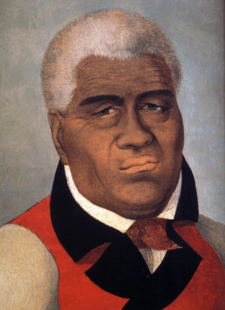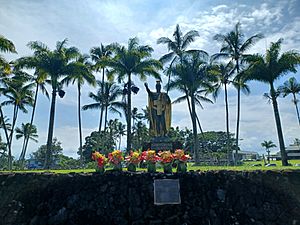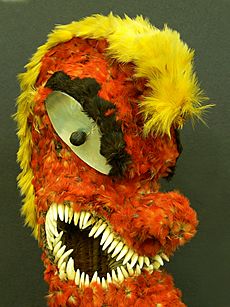Kamehameha I facts for kids
Quick facts for kids Kamehameha I |
|||||
|---|---|---|---|---|---|

Contemporaneous portrait of Kamehameha
|
|||||
| King of the Hawaiian Islands | |||||
| Reign | 1795 – May 8, 1819 | ||||
| Successor | Kamehameha II | ||||
| Born | c. 1758 Kapakai, Kokoiki, Moʻokini Heiau, Kohala, Hawaiʻi Island |
||||
| Died | May 14, 1819 (aged 61) Kamakahonu, Kailua-Kona, Kona, Hawaiʻi island |
||||
| Spouse | (Partial list)
|
||||
| Issue | (Partial list)
|
||||
|
|||||
| House | Kamehameha | ||||
| Father | Keōua Kalanikupuapaʻīkalaninui Ahilapalapa | ||||
| Mother | Kekuʻiapoiwa II | ||||
Kamehameha I (born around 1758 – died May 8 or 14, 1819) was a very important leader in Hawaiian history. He is also known as Kamehameha the Great. He was the first person to unite all the Hawaiian Islands into one kingdom. This was a huge achievement! Today, there's a statue of him in Washington, D.C., honoring his legacy.
Contents
Early Life and Family
Kamehameha was born on Hawaiʻi Island. His birth name was Paiea. His mother was Kekuʻiapoiwa II, and his father was Keōua Kalanikupuapaʻikalaninui. Some stories say he was adopted at birth by the Maui monarch Kahekili II, which was a common custom back then.
Historians believe Kamehameha was born around 1758. This date is sometimes linked to the appearance of Halley's Comet. His early life was spent in the royal court of his uncle, Kalaniʻōpuʻu.
Growing Up in the Royal Court
Kamehameha's father died when he was young. So, his uncle Kalaniʻōpuʻu raised him. Kamehameha grew up learning the ways of a warrior and a leader. He was given to his uncle's wife, Keaka, and her sister, Hākau, to be cared for.
Uniting the Hawaiian Islands
Rise to Power on Hawaiʻi Island
Kamehameha became a powerful figure after his uncle Kalaniʻōpuʻu died in 1782. Kalaniʻōpuʻu's son, Kīwalaʻō, became king. But Kamehameha was given a very important religious role: he became the guardian of Kūkāʻilimoku, the Hawaiian god of war. He also gained control of the Waipiʻo Valley.
Kamehameha and Kīwalaʻō had disagreements. Kamehameha gained the support of several important chiefs from the Kona district. These chiefs included his father-in-law, Keʻeaumoku Pāpaʻiahiahi, and his warrior teacher, Kekūhaupiʻo.
An old prophecy said that whoever could lift the Naha Stone would unite the islands. Kamehameha was able to lift this huge stone, which made many believe he was the chosen unifier. Kīwalaʻō was defeated in the Battle of Mokuʻōhai. After this, Kamehameha and his chiefs took control of Kohala, Kona, and Hāmākua districts on Hawaiʻi Island.
Key Allies and Support
Kamehameha had strong support from his wife, Kaʻahumanu. She was a very smart and powerful woman who advised him. He also got help from British and American traders. They sold him guns and ammunition, which were very important for his army.
Two Westerners, Isaac Davis and John Young, became close advisors to Kamehameha. They married Hawaiian women and helped him with military strategies and weapons.
The Olowalu Incident
In 1790, a British ship captain named Simon Metcalfe had a conflict with a Hawaiian chief. Later, some Hawaiians stole a small boat from his ship and killed a crewman. In revenge, Metcalfe sailed to Olowalu, Maui, and fired cannons at the villagers, killing over 100 people.
Soon after, Metcalfe's son, Thomas, arrived in the Hawaiian Islands on another ship. Chief Kameʻeiamoku, seeking revenge for the Olowalu attack, attacked Thomas's ship. He killed Thomas and most of his crew, but spared Isaac Davis. John Young, from the elder Metcalfe's ship, was also captured by Kamehameha's forces. Both Davis and Young were treated well, given wives, and became valuable advisors to Kamehameha.
Conquering Maui and Oʻahu
In 1790, Kamehameha's army, with the help of John Young and Isaac Davis, invaded Maui. They used cannons from the captured ship to defeat Maui's army in the Battle of Kepaniwai.
In 1795, Kamehameha launched a huge invasion with 960 war canoes and 10,000 soldiers. He quickly took over Maui and Molokaʻi. Then he moved to Oʻahu, landing his troops near Waikīkī.
One of his commanders, Kaʻiana, switched sides and helped the Oʻahu chief, Kalanikūpule. Kaʻiana helped set up cannons on the Nuʻuanu Pali mountain ridge. Kamehameha's forces pushed Kalanikūpule's men back to the Pali Lookout. Kamehameha sent his best warriors to climb the Pali and attack the cannons from behind. They surprised the gunners and took control of the cannons.
With their cannons lost, Kalanikūpule's troops were trapped. In the fierce Battle of Nuʻuanu, Kamehameha's army used traditional spears, muskets, and cannons. Over 400 men were forced over the 1,000-foot cliff. Kaʻiana was killed, and Kalanikūpule was later captured.
Uniting with Kauaʻi
By 1810, Kamehameha had united all the islands except Kauaʻi. He chose to negotiate peacefully with Kaumualiʻi, the ruler of Kauaʻi. His high priest, Kalaikuʻahulu, helped convince Kamehameha not to kill Kaumualiʻi. This peaceful agreement finally united all the Hawaiian Islands under Kamehameha I.
King of the Hawaiian Islands

As the ruler of the united islands, Kamehameha worked to make sure the kingdom stayed strong after he was gone. He created a single legal system for all the islands. He also used taxes to encourage trade with countries like Europe and the United States.
The Law of the Splintered Paddle
One of Kamehameha's most famous laws is the Law of the Splintered Paddle. It came from an event in 1782. During a raid, Kamehameha tripped. Two fishermen, fearing him, hit him on the head with a paddle, which broke. Kamehameha was left for dead, and the fishermen escaped.
Years later, these same fishermen were brought before Kamehameha for punishment. But instead, the king blamed himself for attacking innocent people. He gave the fishermen land and set them free. He then declared his new law: "Let every elderly person, woman, and child lie by the roadside in safety." This law protected innocent people during times of war.
Religion and Advisors
Kamehameha was a very religious king. He was the guardian of the war god Kūkāʻilimoku. The explorer George Vancouver visited Hawaii and saw Kamehameha worshiping his gods. Vancouver wanted to bring Christianity to Hawaii. However, Kamehameha told him that his gods had mana (spiritual power) and that through them, he had become the supreme ruler. Seeing Kamehameha's strong faith, Vancouver decided not to send Christian missionaries from England at that time.
Later Years and Legacy
After 1812, Kamehameha spent his time at Kamakahonu, a place he built in Kailua-Kona. He had many wives and children, which was common for rulers of his time.
Final Resting Place
Kamehameha I died on May 8 or 14, 1819. His body was hidden by his trusted friends, Hoapili and Hoʻolulu. This was an ancient custom called hūnākele, meaning "to hide in secret." It was done because a person's mana (spiritual power) was considered sacred. His final resting place is still a secret today.
Family Life
Kamehameha had many wives, though the exact number is debated. Some records suggest he had around 30 wives, with 18 of them having children. In total, he had about 35 children, including 17 sons and 18 daughters. However, only the children he had with his highest-ranking wife, Keōpūolani, were able to become rulers after him.
See also
 In Spanish: Kamehameha I para niños
In Spanish: Kamehameha I para niños



